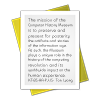Title
Farr, Bill (William) interviewCatalog Number
102792021Type
DocumentDescription
William (Bill) Farr joined the minicomputer company Prime Computer in 1972, the year it was founded, after working as an engineer at Computer Control Company and DEC. He was a lead engineer at Prime in 1975 when the co-founder and vice president of engineering, Bill Poduska, gave him some papers on the ALOHAnet and asked him to start thinking about networking. (Poduska would go on to found Apollo Computer in 1980, known for its high-performance networked engineering workstations.) Farr describes Poduska’s style of management as similar to that of DEC’s founder, Ken Olsen, and to some extent, of Gordon Bell; all three leaders made a point to connect with members of the engineering staff on a daily basis and were superb in their ability to inspire innovation and creativity. Farr soon began reading anything he could about networking, including Robert Metcalfe’s PhD thesis on Ethernet, and papers from Bell Labs on its early ring network.By fall of ’76, Farr and other engineers at Prime had built a 3-node token passing network, and by early ’77 they had installed a 16-node network in the engineering department. Functional, but not yet a commercial product, PrimeNet, as it was known, was used internally to share files and storage drives without having to physically move disk packs back and forth. It soon became a critical part of the engineering department’s production process. Even so, Farr could not get marketing interested in selling it, nor could he get support from management to finance a product.
By late ’77, Prime started using the network adapters to replace an earlier parallel interface connection developed by Paul Severino, which was only meant for short distances. Finally convinced of the importance of networking to sales, management decided to include the token ring adapter boards in many of their computers. Announced in ’79, Prime’s Ringnet provided networking hardware and software for their minicomputers and helped them land contracts with major companies, including Ford Motor Company. Ford became one of Prime’s largest customers and by the time of this interview, had a network of 180 nodes. Initially Ringnet used X.25 protocols, but eventually they supported other protocols and networking architectures such as Ethernet. In 1982 Farr presented a study on the performance of Ringnet at The Hawaii International Conference on System Sciences, where representatives from Xerox PARC presented the results of performance tests on Ethernet. Interestingly, the results showed that they both performed similarly.
In this interview, Farr discusses the early success he achieved with other Prime engineers in developing the internal network at Prime. He describes the common experience of many innovators working within existing companies who are unable to get the support of management to develop their innovation into new products. Farr states that Prime’s competitor DEC learned about Prime’s network early on and, in his opinion, this knowledge helped motivate DEC to develop their own networking capabilities.
Date
1988-04-07Contributor
| Farr, William (Bill), Interviewee |
| Pelkey, James L., Interviewer |
Publisher
Computer History MuseumPlace of Publication
Boston, MAExtent
16 p.Format
PDFCategory
TranscriptionCollection Title
James L. Pelkey collection : history of computer communicationsCredit
Gift of James PelkeyLot Number
X5671.2010Related Records
| 102746648 | James L. Pelkey collection : history of computer communications |


